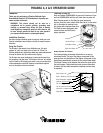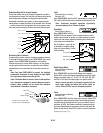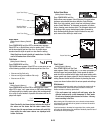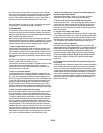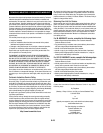
O-14
If your boat remains out of the water for a long period of time, it may take
some time to wet the transducer when returned to the water. Small air bub-
bles can cling to the surface of the transducer and interfere with proper
operation. These bubbles dissipate with time, or you can wipe the face of
the transducer with your fingers after the transducer is in the water.
Never leave the unit in a closed car or trunk—the extremely high tempera-
tures generated in hot weather can damage the electronics.
Troubleshooting
Do not attempt to repair the Piranha yourself. There are no user serviceable
parts inside, and special tools and techniques are required for assembly to
ensure the waterproof integrity of the housing. Repairs should be performed
only by authorized Humminbird technicians.
Many requests for repair received by Humminbird involve units that do not
actually need repair. These units are returned “no problem found.” If you have
a problem with your Piranha, use the following troubleshooting guide before
calling the Customer Resource Center or sending your unit in for repair.
1. Nothing happens when I turn the unit on.
Check the power cable connection at both ends. Be sure the cable is con-
nected correctly to a reliable power source — red lead to positive, black
lead to negative or ground. Ensure the power available is between 8 and 20
VDC. If the unit is wired through a fuse panel, ensure the panel is powered.
Often accessory fuse panels are controlled by a separate switch or the igni-
tion switch.
Also, often a fuse can appear to be good when it is not. Check the fuse with
a tester or replace it with a fuse known to be good.
Check the power connection to the Piranha. It is possible to force the power
cable connector into the cable holder incorrectly. If the connector is
reversed, the unit will not work. Examine the contacts on the back of the
unit to ensure there is no corrosion.
2. There is no transducer detected.
The Piranha has the ability to detect and identify that a transducer is con-
nected. When Powering on, if a message indicates “transducer not connect-
ed”, ensure that an appropriate transducer connector is plugged into the
unit. Second, inspect the transducer cable from end to end for breaks, kinks,
or cuts in the outer casing of the cable. Also ensure the transducer is fully
submerged in water. If the transducer is connected to the unit through a
switch, temporarily connect it directly to the unit and try again. If none of
these items identifies an obvious problem, the transducer itself is probably
the problem. Be sure to include the transducer if returning the unit for repair.
3. There is no bottom reading visible on the display.
If the loss of bottom information occurs only at high boat speeds, the trans-
ducer needs adjusting – see the Piranha Installation Guide. Also, in very
deep water, it may be necessary to manually increase the sensitivity setting
to maintain a graphic depiction of the bottom. If you are using a transducer
switch to connect two transducers to the Piranha, ensure the switch is in
the correct position to connect a transducer that is in water. (If a trolling
motor transducer is selected and the trolling motor is out of water, no sonar
information appears.) If none of the above solve the problem, inspect the
transducer cable from end to end for breaks, kinks, or cuts in the outer cas-
ing of the cable. If the transducer is connected to the unit through a switch,
temporarily connect it directly to the unit and try again. If none of these
items identifies an obvious problem, the transducer itself may be the prob-
lem. Be sure to include the transducer if returning the unit for repair.
4. When in very shallow water, I get gaps in the bottom reading and
inconsistent digital depth indication.
The Piranha will work reliably in water 1m (3') or deeper.The depth is
measured from the transducer, not necessarily from the surface.
5. The unit comes on before I press POWER, and won’t turn off.
Check the transducer cable — if the outer jacket of the cable has been cut
and the cable is in contact with bare metal, you will need to repair the cut
with electrical tape. If there is no problem with the cable, disconnect the
transducer from the unit and see if the problem is corrected, to confirm the
source of the problem.
6. I get gaps in the reading at high speeds.
Your transducer needs adjusting. If the transducer is transom-mounted, there
are two adjustments available to you—height, and running angle.Make small
adjustments and run the boat at high speeds to determine the effect. It may
take several tries to optimize high-speed operation.This can also be a result
of air or turbulence in the transducer location caused by rivets, ribs,etc.
7. My unit loses power at high speeds.
Your Piranha has over-voltage protection that turns the unit off when input
voltage exceeds 20 VDC.Some outboard motors do not effectively regulate the
power output of the engine’s alternator and can produce voltage in excess of
20 volts when running at high RPMs.The SureVolt power stabilizer from
Humminbird maintains a steady voltage to the unit and solves this problem.
8. The screen begins to fade out. Images are not as sharp as normal.
Check the input voltage. The Piranha will not operate on input voltages
below 8 VDC.
9. The display shows many black dots at high speeds and high sensi-
tivity settings.
You are seeing noise or interference caused by one of several sources. Noise
can be caused by other electronic devices.Turn off any nearby electronics
and see if the problem goes away. Noise can also be caused by the engine.
If engine noise is causing the interference, the problem will intensify at high-
er RPMs. Increase the engine speed with the boat stationary to isolate this
cause. Propeller cavitation can appear as noise on-screen. If the transducer
is mounted too close to the propeller, the turbulence generated can interfere
with the sonar signal. Ensure that the transducer is mounted at least 15"
(380mm) from the prop.



